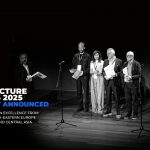In Dialogue with CINZIA FERRARA
“The problem is that people think of LIGHT as something that is given – they take it for granted. You can only understand the power of something when you don’t have it – light : it very much resembles freedom.”
Cinzia Ferrara.: My father was an engineer so it was a lot of fun for him taking me on site during construction. This is the reason why I don’t have any problems with construction sites – I know where to go and how to move around. I think I grew up with this pragmatic and technical part: solving problems because they are going to be there anywhere you go. Even the best project in the world faces some problems and we have to solve them. There is another part of me that comes from my mother. She studied law so I guess I inherited a much more idealistic perspective from her. It was obvious that I was going to go to university, so I started architecture. Then I started working on urban planning because I was fascinated by the multiple things getting together – some kind of big mess around. At one point I did a one year master in lighting design and I decided I was interested in this area because I couldn’t touch it or grab it.
Andreea Movila.: As the result may only come in a long period of time.
C.F.: Exactly! I’ve always worked with light, be it natural or artificial.
A.M.: Do architects come to you and invite you to collaborate with them for their projects?
C.F.: Most of the time there are architects who come to me because they want a professional to take care of the lighting. There can also be developers who think that light can be very interesting in private or public spaces because life has changed a lot – we’re doing so many things during night time now. This is what I like best because I enjoy the idea of working with people; I don’t like to work by myself, I like to exchange a lot of comments or ideas. A nice thing when working with architects is that even when you think they might be similar, they’re not… First you understand there is a process in order to get to a certain result and then you can add your own philosophy because there is no way to do it from outside of it.
A.M.: You also have to understand the story of the project you have to work on. Do you have any sort of discussion with the author? Do they tell you what to do or do you have your own proposals?
C.F.: Architects are more influential in general. I must say that the biggest architects I worked with were more open-minded in the way that they didn’t explain anything. The important thing is to understand what the project is about and the client’s desires and ideas and translate them into lighting. One client told me ‘Only two things are important to me: light and sound. Light has to be clear and well done’. I immediately made it clear I wasn’t the person who liked decorative lighting. I like the understatement of lighting – it means that it is there but you don’t have to see it. If you like the space that means the light is probably fine but if you notice something, that means something is wrong. For example, you know the light is good in a museum when you don’t just go out and talk about the lighting – you just feel fine and the works of art are at the centre of attention.
A.M.: What is your feeling about Italian architecture?
C.F.: I think that we are going through a dark period because architecture is suffering from something that we all know – whoever has the money to build asks for some names instead of getting someone who is able to connect things together and all the projects are not that site-specific: they look like they’ve just been dropped on Earth from the moon. That’s why I said the problem is with the clients.
A.M.: It should be interesting to live in a country where statics show there are the most architects per inhabitant in Europe. As we perceive architecture in relationship with culture, we can consider is a country of great culture, and what it actually is.
C.F.: Absolutely! We definitely have the most architects but not all of them do architecture – a lot of people just study architecture but have other professions.
A.M.: I perceive it as a good thing. I won’t worry about a too high number of people graduating from architecture schools because they will contaminate the society with their good taste and common sense.
C.F.: Don’t forget that people who study architecture will become architects that don’t get to make great things. I agree with you – I think that we have been very lucky to work on very creative things but now we have to get back to solving more pragmatic construction problems. Anyway, what I sometimes see in the schools of architecture and even design schools is that if you are not curious enough to study different things, your vision tends to diminish and your creativity has a lack of vision. I always say two things: ‘Why don’t you try to look very high and then there is always time to go down? Look at the moon!’
A.M.: If you want to reach the moon, you might end up between the stars – an achievement on its own.
C.F.: Exactly! Moreover, you have to be confident that you do something that makes you happy. If you don’t, that means something doesn’t work. If you do something and you wouldn’t be the first person you’d go to, something is clearly wrong.
A.M.: This is what you would advise a young architect? What other things do you consider important at the start of a career in architecture?
C.F.: Being curious for sure and being able to travel as well. This also applies to the clients because they’re always talking about certain things and you must know what they’re talking about. The other thing is going back to study the classical things – not because you have to know how they are made, but in order to understand why certain things were made like that. It’s not the power of knowing a lot of things, but understanding how something works. Why does it work so well? What is it exactly? You have to be precise because the people you’re talking to don’t always understand your point.
A.M.: How would you perceive the “temperature” of the architectural field today?
C.F.: I think the profession is going through a crisis all over the world. Most of the professions lost a lot of their power in terms of relevance and architects are a bit weaker in front of the clients. What’s more, the ‘old world’ is shrinking in a way – a lot of architects went to a new gem (the Far East or the Middle East). Some of the results were not so wonderful and architecture became more like a game of power instead of concentrating on doing something meaningful. When you work for the Middle East, most of the time you don’t get to be a part of the drawings because it’s too expensive for them and they don’t know exactly how you work on the site and many other reasons. This means you’ll have no control over the final project, so whatever is being built will be different from what you’ve done. That’s why all the architects are pushing forward – we have to try occupying more space in a nice way. But the problem is the market – it has nothing to do with other specific fields, this is how the world works now. Second of all, time schedules changed.
A.M.: There is a lot of pressure.
C.F.: You cannot have time for everything now. And let me tell you that a lot of big architects are very happy to work with different offices.
A.M.: The complexity of the projects skyrocketed exponentially.
C.F.: Anyway, as I said, it is the market that has really changed. What I have to do is actually find the best solution in order to make you project viable.
A.M.: Which aspects of the architectural profession brings you a lot of joy?
C.F.: When I’m looking for balance and rhythm with my client – that’s like music. You cannot make your own music, so you have to ‘play’ with the architect. There is one moment I feel I understood what he was saying and that moment is very exciting.
A.M.: I would call light a power because it puts the spot on everything and there is a high responsibility to work with it. How do you feel about working with light?
C.F.: Very powerful! [laughs] When I work with an architect I know and we don’t agree about something I always say ‘Be careful! If you’re bad, I will destroy your project!’ [laughs]. The problem is that people think of light as something that is given – they take it for granted. You can only understand the power of something when you don’t have it – light : it very much resembles freedom. That’s why I think we have to work carefully and it’s not a matter of money – it’s about creativity, sensitivity, innovation and technical capacity.
A.M.: To what extent do architects involve you in their projects from the beginning considering natural light?
C.F.: I can give you two examples. Many years ago there was a building and somebody said ‘I think the light inside the building doesn’t work for a certain reason. Can you do something?’ In the end they changed something but that’s a pity if it happens in the very last stage. If we go back to Venice, with Punta della Dogana we had to maintain the same surface and the requests were clear from the beginning. So it might happen that you work with an architect from the start and this would render good results in the end.
A.M.: I would militate for architects understanding how important it is to collaborate with lighting specialists from the beginning.
C.F.: A lot of architects have an idea and want to follow it no matter what. In 2019 we have to be able to control what we are doing and understand the process. The good thing about technology is that it can be used as a tool to achieve certain goals and not vice-versa. What happens sometimes is that people do some things and go back and use the technology in order to modify the parts that went wrong.
A.M.: Indeeed, this is not the right way to work as it wastes energy on solving problems that could have been avoided from the beginning. Summing up, I would ask what is the best piece of advice you’ve received in your career?
C.F.: When I first started I used to work with an urbanist and although it was tough, she was fantastic. She was looking at cities like they were rooms, no matter how big they were. The attention, the details and the analysis of the morphology of buildings – these all shocked me. You feel a bit arrogant in the beginning, you think you know everything, but when I was working with this lady who was very careful with all the details I started asking myself ‘Who am I?’ What I learnt a lot about light – because I was born in Sicily and I’m living in Milan – is that natural light is completely different from north to south. This thing can also be observed in art – the northern light that was depicted in Tiepolo’s fresco or Canaletto’s paintings was this diffused, rarefied light and when you go south you think about Caravaggio who was very extreme with his shadows and sharp contrasts. I believe that the contrast between the two types of light has been on my mind for a very long time and managed to fascinate me. This is what you do with light – you look at things from a different world in some sort of way because you look at what light does with all the bending shadows and contrasts.
A.M.: I believe that many architects should understand the value of this field that complements architecture with grace and complexity. Thank you for your time!




